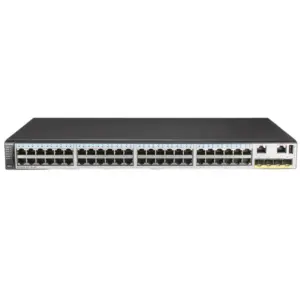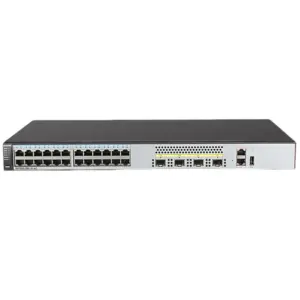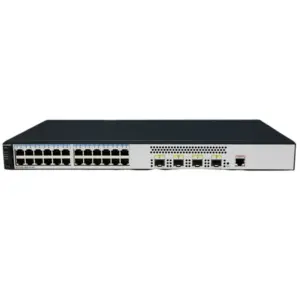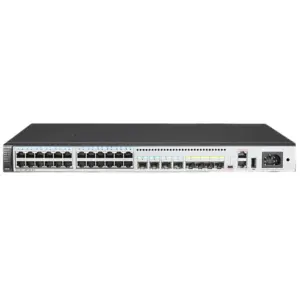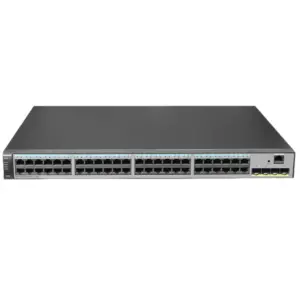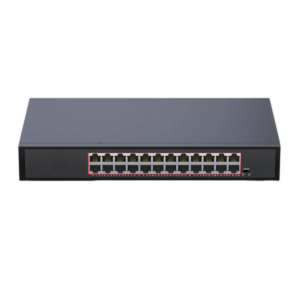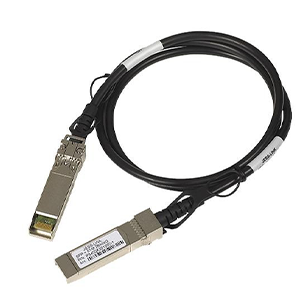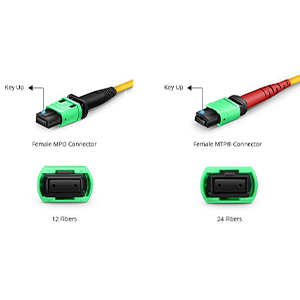Thank you very much for choosing to read this article. Today I will introduce you to 1GB switches and their important role in the network. The 1GB switch is a key network device that enables fast switching and forwarding of data in the network through its high-speed transmission capability and flexible port configuration. Let’s take a closer look at the fundamentals of 1GB switches and their importance in a network.
Basic overview of 1GB Switch
A 1GB switch is a network device used to switch and forward data packets in a local area network (LAN). It supports data transfer rates of 1 gigabits per second (1GB) and provides multiple Ethernet interfaces for connecting computers, servers, network storage devices, and other network devices.
Fundamental:
The basic principle of 1GB switch is to use store and forward or fast forwarding to process network data. When a data packet arrives at the switch, the switch checks the destination MAC address of the data packet and determines which interface to send the data packet to based on the internal forwarding table. The switch records the source MAC address and corresponding interface in order to build a forwarding table. Once the forwarding table is established, the data packet will be forwarded to the corresponding destination.
The role and importance of 1GB switches in the network:
- Provide high bandwidth: 1GB switches support a data transfer rate of 1 gigabit per second and can provide higher bandwidth capacity than lower-speed switches (such as 100MB switches). This is critical for handling large data transfers, multimedia streaming and high-speed network applications.
- Realize network segmentation: The 1GB switch can divide the LAN into multiple virtual LANs (VLANs) to achieve network segmentation and isolation. This helps improve network performance, security, and manageability.
-Support fast data forwarding: The 1GB switch uses high-speed forwarding technology to quickly process and forward data packets, providing low-latency and high-throughput network connections. This is important for real-time applications, video streaming, and large-scale data transfers. - Provide flexible network connections: 1GB switches usually provide multiple Ethernet interfaces, which can connect multiple computers, servers and other network devices. They support flexible network topology and communication between devices, making the network architecture more flexible and scalable.
In summary, 1GB switches play an important role in modern networks. It provides high-bandwidth, low-latency data transmission, supports network segmentation and flexible connections, and provides key infrastructure for achieving high-performance, reliable LANs.
Comparison between 1GB Switch and other switches
Compared with other speeds or types of switches, 1GB switches have the following similarities and differences:
-
10GB switches: 10GB switches support higher data transfer rates, up to 10 gigabits per second (10GB). It provides greater bandwidth capacity and faster data transfer speeds compared to 1GB switches. However, 10GB switches are generally more expensive and require equipment that supports 10GB Ethernet interfaces to take full advantage of their benefits.
-
100MB switch: The 100MB switch is an earlier Ethernet switch that supports a data transfer rate of 100 megabits per second (100MB). Compared to 1GB switches, 100MB switches have lower bandwidth capacity and slower data transfer speeds. They have limited use in modern networks and are typically used in smaller networks or scenarios that require lower bandwidth requirements.
The advantages and applicable scenarios of choosing a 1GB switch include:
-
Cost-effectiveness: Compared with 10GB switches, 1GB switches are more affordable. For small and medium-sized businesses or organizations with limited budgets, 1GB switches are a more suitable choice.
-
Bandwidth requirements: For most small and medium-sized enterprises and office environments, the 1 gigabit per second bandwidth capacity of a 1GB switch is sufficient to meet daily network needs. Higher-speed switches should only be considered if you need to handle large amounts of data transfer or for specific high-performance applications.
-
Equipment compatibility: 1GB switch widely supports Ethernet interfaces of various computers, servers and network equipment. Most modern devices are able to connect to a 1GB switch and communicate normally without the need for additional device upgrades.
-
Management and maintenance: 1GB switches are generally easy to configure and manage. They may require less complexity and expertise to maintain and operate than higher-speed switches.
In general, choosing a 1GB switch is suitable for small and medium-sized enterprises, office environments and general network demand scenarios. They provide sufficient bandwidth capacity, are cost-effective, and are compatible with a wide range of devices. For specific high-performance needs, such as large-scale data centers or high-density server environments, higher-speed switches may need to be considered.
Performance evaluation of 1GB Switch
Evaluating the performance indicators of 1GB switches involves throughput, forwarding speed, and latency. Below is an explanation of these metrics and a discussion of the impact on network performance and user experience:
-
Throughput: Throughput refers to the amount of data that the switch can process per unit time. Expressed in gigabits per second (Gbps). Higher throughput means the switch can handle more data and support greater data traffic. For network performance and user experience, high throughput helps provide fast data transfer and response times, especially when handling large data transfers or streaming applications.
-
Forwarding Rate: Forwarding rate refers to the number of data packets that the switch can process and forward per second. Expressed in packets forwarded per second (PPS). Higher forwarding speed means the switch can handle more packets and support more concurrent connections. For network performance and user experience, high forwarding speed helps achieve fast packet forwarding and low latency, ensuring smooth real-time applications and network interactions.
-
Latency: Latency refers to the time required for a data packet to enter the switch from the input port to leave the switch from the output port. Latency is affected by multiple factors, including processing time, transmission time, and queuing time. Lower latency can provide faster response times and a smoother network experience. For real-time applications such as voice calls or video conferencing, low latency is critical, while for general data transmission, a switch with higher latency may not have a noticeable impact on the user experience.
These performance indicators have an important impact on network performance and user experience. High throughput and forwarding speed can support greater data traffic and more concurrent connections, providing fast data transmission and response time. Low latency helps real-time applications run smoothly and reduces network delays.
Therefore, when selecting a 1GB switch, you need to comprehensively consider these performance indicators and select a suitable switch based on specific network requirements and application scenarios to ensure good network performance and user experience.
Installation and configuration of 1GB Switch
Installing and configuring a 1GB switch requires following the following steps and precautions:
Install the switch:
- Place the switch in a location that provides adequate ventilation and is not subject to overheating or physical damage.
- Connect the switch’s power adapter and make sure it is powered correctly.
- Use an appropriate Ethernet cable to connect one of the switch’s Ethernet interfaces to a router, firewall, or higher-level switch in the network.
Connect the device:
- Use Ethernet cables to connect computers, servers, and other network devices to the switch’s other Ethernet interfaces.
Basic configuration:
- Using a computer connected to one of the Ethernet ports on the switch, open a web browser.
- Enter the switch’s management IP address (usually the default) or hostname and follow the instructions provided by the switch manufacturer to log in to the management interface.
- In the management interface, perform basic settings, such as setting the administrator password, setting the host name, etc.
VLAN configuration:
- If you need to create a virtual LAN (VLAN), find the relevant configuration options in the management interface.
- Create the required VLANs and assign the corresponding interface to each VLAN.
- Configure VLAN attributes, such as VLAN ID, name, IP address, etc.
Port aggregation configuration:
- If you need to use the port aggregation (Link Aggregation) function, find the relevant configuration options.
- Select the interfaces to be aggregated, and configure the parameters of the aggregation group (Aggregation Group), such as aggregation type, mode, priority, etc.
Save and apply configuration:
- After completing the configuration, be sure to save the configuration changes and apply them to the switch.
- The switch will reboot to apply the new configuration.
Precautions:
-Be sure to fully understand the switch’s management interface and configuration options before making any configuration changes. Refer to the switch user manual or documentation provided by the manufacturer.
- Before making any configuration changes, it is recommended to back up the current configuration of the switch in case of misconfiguration or need to revert to a previous state.
- Follow network design principles and best practices to ensure appropriate subnetting, IP address planning, and security settings.
- When configuring VLAN and port aggregation, ensure that all related devices (such as routers, servers) are also configured correctly to support the corresponding functions.
Virtual LAN (VLAN) and port aggregation (Link Aggregation) are important settings in the 1GB switch. VLAN allows the network to be divided into multiple logical network segments, increasing network security and management. Port aggregation allows multiple physical interfaces to be bundled into a single logical interface, providing higher bandwidth and redundancy. When configuring these features, ensure that VLAN IDs, interface assignments, and connection modes are set correctly to achieve the desired network topology and performance goals.
Application cases of 1GB Switch
1GB switches are widely used in different scenarios. The following are some common application cases:
-
Home network: In a home network, a 1GB switch can connect multiple devices, such as computers, smartphones, game consoles, and network storage devices. It can provide fast LAN connection and support family members to conduct multiple online activities at the same time, such as high-definition video streaming, online gaming and file sharing. In addition, by configuring VLAN, the home network can isolate different devices and enhance security.
-
Small offices: For small offices, 1GB switches can connect office computers, printers, IP phones, network storage devices, etc. It provides high-speed internal communications, supporting fast file transfers, collaboration, and printing tasks. In addition, through the setting of VLAN, devices of different departments or functions can be isolated to improve network security and management efficiency.
-
Small and medium-sized enterprise networks: In small and medium-sized enterprise networks, 1GB switches can be used to build LAN infrastructure. It can connect various devices, such as office computers, servers, storage devices, IP phones, surveillance cameras and wireless access points, etc. By configuring VLAN and port aggregation, group management, bandwidth optimization and redundancy backup of network resources can be achieved, improving network performance and reliability. In addition, some 1GB switches also provide advanced features such as QoS (Quality of Service) and security enhancements to help optimize network traffic and protect corporate data.
The 1GB switch application in successful cases can reflect its role in improving network performance and data transmission efficiency. Here are a few examples:
-
In a home network, using a 1GB switch enables seamless playback of HD video streaming while allowing other family members to play online games or file downloads, providing a good user experience and smooth network connection.
-
In small offices, using 1GB switches can achieve fast file transfer and printing tasks, improving work efficiency. In addition, by configuring VLAN, office computers and sensitive data devices can be isolated from guest devices to provide a secure network environment.
-
In small and medium-sized enterprise networks, fast internal communication and high-speed data transmission can be achieved using 1GB switches. By configuring port aggregation, bandwidth and redundancy backup can be increased to ensure network reliability and stability. At the same time, VLAN can be used to group devices of different departments or functions for management, improving network security and management efficiency.
The price and cost performance of 1GB Switch
The price of 1GB switches varies based on factors such as brand, model, and features. Here are the price ranges and features of some common brands and models for reference:
Cisco:
- Cisco Catalyst 2960 Series: Price range from hundreds to thousands of dollars, offering high reliability, security, and advanced feature-rich features. Suitable for small and medium-sized enterprises and large network environments.
- Cisco SG Series (Small Business Switches): Prices range from tens to hundreds of dollars, providing basic switching functions and reliable performance, suitable for small offices and home networks.
HPE (Hewlett Packard Enterprise):
- HPE OfficeConnect 1920S Series: Price range from a few hundred dollars to around a thousand dollars, featuring ease of use, reliability and security. Suitable for small and medium-sized businesses and small offices.
- HPE Aruba 2530 Series: Priced from a few hundred dollars to around a thousand dollars, it offers high performance, scalability, and security for small and medium-sized businesses and large network environments.
3.TP-Link:
TP-Link JetStream Series: Priced from tens to hundreds of dollars, it provides reliable performance, ease of use and basic management functions for small offices and home networks.
TP-Link Smart Series: Price ranges from tens to hundreds of dollars, with basic switching functions and some advanced features, suitable for small offices and home networks.
Summarize:
When choosing a 1GB switch, you can compare different brands and models based on their price ranges and features to match your budget and needs. If you are interested in 1GB switches, please consider contacting us. We will provide you with professional advice and support to help you choose a cost-effective 1GB switch to improve the performance and data transmission efficiency of your network.
Is 1gb switch enough?
What is a 1gb switch?
What is the speed of a 1gb switch?
What is the difference between 100 MB and 1gb switch?
What is the difference between 1Gb switch and 10Gb switch?
What is the difference between 1Gb and 2.5gb switch?
Is 1gbps overkill?
Why use a gigabit switch?
Does a gigabit switch slow down?


